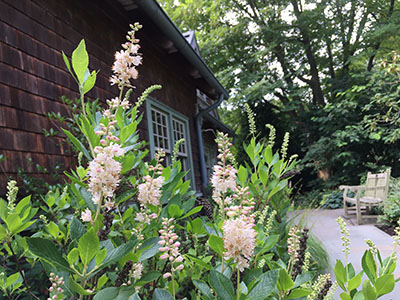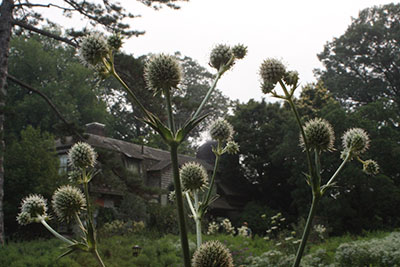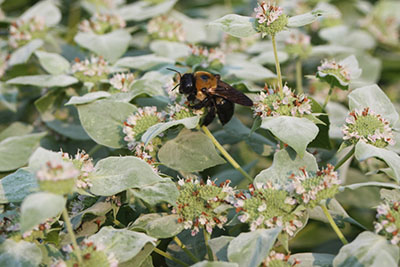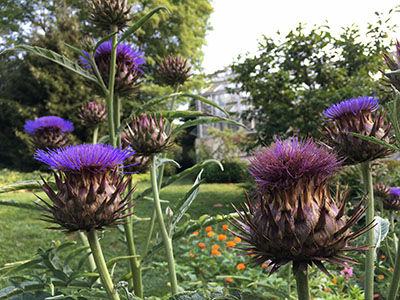
Plants of the Week: July 19
Guest Author: Julia Hackstie

I was first drawn to Clethra alnifolia (sweet pepperbush) in the foundation bed of the Wister Center earlier this year with its grayish-brown seed capsules that persisted from last season. In fact, it’s common name suggests a likeness of the fruits to peppercorns. Now as we approach late summer, the buds of Clethra alnifolia are hinting with the faintest pale blush pink, and have begun to open white, spikes of bottlebrush flowers.
Native to coastal states of the eastern U.S., this deciduous suckering shrub prefers moist soils, but once established can tolerate dry conditions. It hosts a plethora of winged visitors, providing bees and butterflies with essential nectar and pollen at a critical part of the season. Perfect for smaller garden spaces, Clethra alnifolia ‘Crystalina’ [Sugartina®] is a dwarf cultivar growing to 2-3 feet high. Placing it under a first floor window, at the foot of your front stoop, or towards the front of your shrub border would allow you to enjoy its sweet summer scent. Its deep green leaves turn a pale gold in the fall. Many other cultivars can be found throughout the Arboretum. Photo credit: J. Hackstie

Another current bloomer reviving the mid-summer landscape is Eryngium yuccifolium, or rattlesnake master, which can be seen in the Scott Entrance Garden. Present in meadows throughout much of the mid- and eastern- U.S., the foliage of this wildflower perennial resembles that of the yucca plant (as its name implies) or another plant that might be found in the desert southwest. Its blooms are oddly wonderful globular clusters of tiny flowers sitting on branched, spiky three-foot stems. Each cluster can have as many as 106 individual white flowers which give off a silverish cast to the garden, making it an excellent contrasting companion to native grasses, rudbeckias and echinaceas. The plant attracts a diversity of small bees, beetles, moths, flies and solitary wasps. It is also a host plant of the Black Swallowtail butterfly, making it an excellent addition to your pollinator or rain garden. This plant does best in full sun and moist soils but will tolerate medium-dry conditions. I personally don’t think you can plant too many of these!

Swaths of Pycnanthemum muticum (short-toothed mountainmint) are currently blooming around the Arboretum, but perhaps most noticeably in the Scott Entrance Garden and Biostream. I don’t think too much can ever be said about short-toothed mountainmint. It boasts one of the highest values for wildlife of any of our Eastern U.S. native perennials, so it should be considered a principal plant in your pollinator garden. According to a three-year Penn State Extension Pollinator Trial concluding in 2015, it attracted the highest quantity and diversity of bees, butterflies and other pollinators. Tiny, tubular pink to lavender flowers open on clusters which are subtended by two silvery bracts. This is another great option for those who love silvery tones in their gardens, especially at a time in the season when our gardens can use a little revitalization.
Extremely long blooming (over two months!) and deer resistant, it prefers full sun to part shade and needs room to establish as it will colonize via shallow rhizomes. It’s not as invasive as true mints, and its spread can be controlled easily in your garden by pulling unwanted plants. Leaves and flowers can be dried and used in homemade herbal teas. Native Amercians used this plant to treat stomach aches. Fresh stems can be cut and used in floral arrangements where the minty scent will infuse your living space for days. I like to leave the spent plants standing to provide winter interest to the garden.Photo credit: J. Hackstie

I walk past the Cut Flower Garden several times daily, and many plants there have captivated me but none more than Cynara cardunculus, commonly referred to as the cardoon or artichoke thistle. Native to the Mediterranean region, this plant is equal parts something to behold and something to harvest. Since the medieval times, the inner parts of the celery-stalk-like structure supporting spiny spear-shaped leaves have been braised, boiled, fried and pickled in France, Spain, and Italy. In Spain and Portugal, the pistils of the cardoon flower are used even today as a vegetable rennet in cheesemaking. The unopened flower bud itself, resembling a very small artichoke, can also be eaten. In the late 1700’s, Quakers reportedly introduced the cardoon to American kitchen gardens.
It can be argued that the cardoon may be best used left standing in the garden as a striking specimen with its unusual architecture and deep violet-blue flowers that attract bees and butterflies. A perennial in Zones 7-10, you will want to give this plant full sun and lots of space – it can reach 6 feet tall. Harvesting tips and recipes are abundantly available online. Cut spent flower stalks before they set seed to use in indoor arrangements or wreaths. Interestingly, there is current research looking into the use of this plant as biofuel and oil extracted from its seeds as biodiesel. Photo credit: J. Hackstie





No Comments